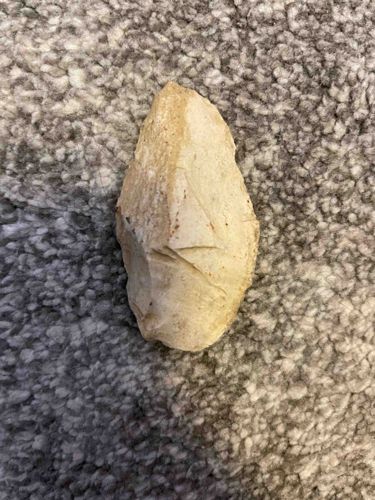
Prehistoric Stone Hand Axe / Biface
The item appears to be a stone tool, specifically a biface or hand axe, crafted from a light-colored, possibly chert or flint, material. Its primary color is a pale cream or off-white, with some areas exhibiting a light tan or brownish hue, suggesting natural variations in the stone or surface patination from environmental exposure. The tool has an elongated, almond-like or ovate shape, tapering to a somewhat pointed end on one side and a broader, less refined base on the other. It exhibits clear evidence of knapping, with numerous flake scars visible across its surface, indicating that it was shaped by striking flakes off a larger core. Some of these scars are quite deep and clear, reflecting intentional modification for utilitarian purposes. The edges appear relatively sharp in some sections, consistent with a cutting or chopping implement, though the overall condition suggests significant age and potential wear. There are no obvious signs of recent damage or repairs; the texture appears natural for a well-weathered stone artifact. The craftsmanship, while rudimentary by modern standards, demonstrates a skillful understanding of lithic reduction techniques, characteristic of prehistoric tool making. No discernible modern markings or signatures are visible, reinforcing its likely ancient origin. Its overall form suggests it was designed for gripping in the hand and could have been used for a variety of tasks such as butchering, chopping, or scraping.
AI-Generated Appraisal Disclaimer
Estimated Value
$600-900
Basic Information
Category
Archaeological Artifact/Tool
Appraised On
November 30, 2025
Estimated Value
$600-900
Item Description
The item appears to be a stone tool, specifically a biface or hand axe, crafted from a light-colored, possibly chert or flint, material. Its primary color is a pale cream or off-white, with some areas exhibiting a light tan or brownish hue, suggesting natural variations in the stone or surface patination from environmental exposure. The tool has an elongated, almond-like or ovate shape, tapering to a somewhat pointed end on one side and a broader, less refined base on the other. It exhibits clear evidence of knapping, with numerous flake scars visible across its surface, indicating that it was shaped by striking flakes off a larger core. Some of these scars are quite deep and clear, reflecting intentional modification for utilitarian purposes. The edges appear relatively sharp in some sections, consistent with a cutting or chopping implement, though the overall condition suggests significant age and potential wear. There are no obvious signs of recent damage or repairs; the texture appears natural for a well-weathered stone artifact. The craftsmanship, while rudimentary by modern standards, demonstrates a skillful understanding of lithic reduction techniques, characteristic of prehistoric tool making. No discernible modern markings or signatures are visible, reinforcing its likely ancient origin. Its overall form suggests it was designed for gripping in the hand and could have been used for a variety of tasks such as butchering, chopping, or scraping.
Get Your Items Appraised
Instant estimates of your treasures with AI-powered instant appraisals